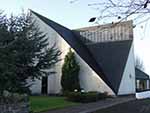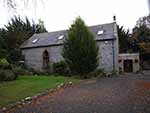On the banks of the Grand Canal, proudly sits the little chapel of St. Anne. It is a neat building set in a well kept garden under a big beech tree. It comprises one room, a gallery, a sacristy, one confession box and a porch. The entrance to the gallery is on the outside at the back. The building and its surrounds bear witness to the loving care lavished on it by the people of Ardclough over its 175 years. It is well kept, well polished, its brasses burnished, the pathway always lined with flowers, snowdrops or daffodils. Its two stained glass windows lend a peaceful atmosphere, one feels nearer to God here, its simplicity is of times long past, a quite place in our ever more hectic world. It has served us and the proceeding generations well from the cradle to the grave.
St Anne’s chapel was built in 1810 by the Right Honorable Valentine Browne Lawless, 2nd Baron Cloncurry, on a site donated by him at Ardclough beside the newly built Grand Canal. He was the local landlord of the area and resided at Lyons Estate, now the property of University College, Dublin. In the Life and Times of Lord Cloncurry dated 1855, the building of the new chapel at Ardclough is mentioned also the fact that he bestowed on the church alarge bronze crucifix and holy water font of white marble. These he had brought from Italy in 1805. The cross was a personal gift from Pope Pius VI1.
Lewis, in his Topographical Directory of 1837, wrote of Ardclough “a neat plain building”, and Fr. M.A. Comerford M.R.I.A. wrote in his “Collections”, in 1833 “there are seventy members of confraternities and two hundred communicants monthly, and between Kill and Ardclough there are six suits of vestments and three chalices”.
When all is said and done, a church, no matter how beautiful, is just stone, it is the community about it that gives it life. The clergy and alterboys that have served there – too numerous to mention. The collectors, of another era – Tom O’Rourke, Jim Byrne, Joe Norton, Paddy O’Connor, and Jim Tancred followed by the present generation of collectors – Johnny O’Grady who has spent a record number of years serving Ardclough, and Tony O’Brien. Its sacristans – the late Mrs. Dunne who lived beside the church and gave the priest his breakfast in the sacristy before he returned to Kill in his pony & trap. The late Mrs. Tully a teacher in the local school, Mrs. Graham, Mary Mangan, the late Mrs. Butler, and many more ladies. The present sacristan, Mrs. Patricia Christian, has more than maintained the high standards of her predecessors. Mrs. Farrell has been helping her with the flowers. The crib, an outstanding feature each Christmas, was erected by the late Sonny Cullen.
In the 1930’s, the late Mrs Brigid Maguire, Principal teacher at Ardclough school put on a play to raise funds for an organ for the church. Mrs Costello plays the organ at Mass every Sunday.
While we say goodbye to the old church, let us look forward to the new. It is due to the inspiration of the priests, and people of Ardclough that the dream of a new church has come true, it is a measure of their faith in the future, so we welcome it, wish it well and the coming generations that will pass through its door.
Lord Cloncurry also built a school beside the church in Ardclough, became its patron, and denoted £10 per annum to its upkeep. It is mentioned by Rev. Martin Brennan in his Schools of Kildare and Leighlin AD 1775-1835, that Sunday School was held there from 9am to 2pm where 200 children received moral instruction. This school was closed in 1949 and moved to a site beside the canal bridge near the new church.
St Anne’s chapel has served the faithful of the area well through good times and bad. It has seen great changes in our country, Catholic Emancipation, famine, insurrection, the disappearance of the landlord system, Independance, two world wars and the winds of change that blew through the church in the 1960’s. The chapel itself has remained unchanged, except for a few embellishments here and there through the pennies of the faithful. The mass paths still wind down from Oughterard Hill, through Boston and past the quarries where Arthur Guinness quarried the stone to build his brewery at St. James Gate, in Dublin.
It is a monument to the faith and love of past generations, and it is a sad moment when we bid our chapel farewell, standing in the May sunshine under the big beech tree, gazing across the tranquil waters and green banks of the Grand Canal, proud of work well done.



